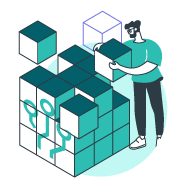Ever sat through a meeting where someone casually dropped "composable CDP" into the conversation, and you nodded along while secretly thinking, "What on earth does that actually mean?".
Don't worry—you're not alone. The world of customer data platforms is evolving rapidly, and keeping up with the terminology can feel like trying to drink from a fire hose.
Let's break it down simply: a composable CDP is a flexible, modular approach to managing customer data that works with your existing systems instead of replacing them.
Traditional CDPs are often all-in-one solutions that require you to adopt their entire ecosystem. They're like those kitchen gadgets that claim to do everything—chop, blend, and cook—but actually don't excel at any single function.
A composable CDP, on the other hand, is more like having specialised tools that work perfectly together. Composable CDPs like Wondaris let you pick and choose the best components for each aspect of customer data management: collection, storage, analysis, and activation.
| Traditional CDP | Composable CDP | ||
| Functionality | One size fits all | Individual components can be selected, added, removed. | Individual components can be selected, added, removed. Focused on specific Use Cases |
| Data Storage | Data stored & duplicated outside of your infrastructure | Data stored in existing cloud infrastructure.Full data control and ownership. | Data can be stored in your data infrastructure ORin Wondaris’ infrastructure – owned and controlled by you within your cloud. |
| Data Science and AI | Fixed, ‘black box’ models | Add and adjust Custom models | Curated, simple models AND custom modelling capabilities |
| Implementation | Minimum 6 months | 1-6 months | 1-6 months |
| Cost | Full packaged license cost | Cost adjustable based on components required | Cost adjustable based on components required |
Think about how you use your smartphone. Years ago, you might have carried a separate camera, GPS device, music player, and phone. Now, you have specialised apps on one device that do each job brilliantly and work together seamlessly.
That's essentially what's happening with CDPs. Companies realised that the one-size-fits-all approach wasn't cutting it anymore.
According to research from Dinmo, organisations are increasingly favoring composable CDPs because they can "choose the best-in-class solutions for each layer of the CDP, including data collection, storage, modeling, and activation". This modular approach gives businesses unprecedented flexibility.
A composable CDP typically consists of several key components that work together:
What makes this approach different is that each component can be best-in-class for its specific function rather than being mediocre parts of an all-in-one solution.
Let's cut through the marketing speak and look at what composable CDPs actually deliver:
Remember that time you wanted to switch phone providers but couldn't because you'd lose your number? That's vendor lock-in, and it's frustrating. Traditional CDPs often create a similar problem—once your data is in their system, moving becomes painful.
With a composable CDP, your data typically lives in your own data warehouse. If you want to change vendors for any component, you can do so without massive disruption. As noted by Databricks, composable CDPs reduce "the risk and cost associated with migrating to another platform" by "placing customer data in an open lakehouse".
Many companies have already invested heavily in data infrastructure. A composable CDP leverages these investments rather than requiring you to start from scratch.
Composable CDPs integrate with existing data infrastructure, avoiding vendor lock-in and the need for rebuilding the entire customer data stack. This means you can enhance what you already have rather than replace it entirely.
With composable CDPs, you have the ability to select the components of a Customer Data Platform that compliments your existing data warehouse or data stack. No need for a huge enterprise license for a plethora of CDP capability you don't need and won't use.
Let's face it—customer data needs to change constantly. One month you might need to focus on email personalisation, the next on predicting customer churn.
A composable CDP adapts more easily to these changing priorities. They provide immediate access to all data types, accommodating complex use cases and avoiding the limitations of traditional CDPs.
With privacy regulations getting stricter by the day (hello, GDPR and CCPA!), having clear visibility of your data handling is crucial.
Composable CDPs provide full transparency, lineage, assurance, and auditability, ensuring compliance with these regulations. This transparency isn't just good for avoiding fines; it also builds customer trust.
Traditional CDPs often charge an enterprise-grade license based on the volume of data you process. You generally get access to capability you don't need, and as your business grows, these costs can skyrocket unexpectedly.
With a composable approach, you have more control over costs since you're typically leveraging your existing data warehouse rather than paying to duplicate data in yet another system.
Select Composable CDP's like Wondaris enable you just to pay for the solutions you need, rather than having to pay for the full-stack of CDP capability you may not need.
Let's move beyond theory and look at how businesses are actually using composable CDPs:
We've all had that unsettling experience of talking about something and then immediately seeing an ad for it. That's bad personalisation.
Good personalisation feels helpful rather than intrusive. Composable CDPs enable this by giving marketers a complete view of customer behavior while respecting privacy. Composable CDPs enable personalised experiences by leveraging unified customer data, including targeted messaging, tailored offers, and individualised content recommendations.

Understanding how customers interact with your brand across different touchpoints used to require piecing together fragments of data from various systems.
A composable CDP creates a unified view, making it easier to spot where customers are getting stuck or dropping off. As Databricks notes, they help "map and analyse customer journeys across different touch points, optimising the customer journey and identifying pain points".
How many times have you purchased something online, only to be bombarded with ads for that same product afterward? That's poor cross-channel coordination.
Composable CDPs help ensure that all your marketing channels are working from the same customer data in real-time, creating more coherent experiences. They facilitate cross-channel campaigns by synchronising data with various business tools, ensuring a consistent customer view across all channels.
Not every organisation needs a composable CDP. You might consider this approach if:
- You already have significant investments in data infrastructure
- Your business has complex, unique requirements that off-the-shelf solutions don't address
- Your team has the technical capability to integrate different systems
- Data security and ownership are top priorities for your organisation
On the flip side, smaller organisations with limited technical resources might still benefit from traditional all-in-one CDPs that offer simplicity, even if they sacrifice some flexibility.

The trend toward composable architectures isn't limited to CDPs—it's part of a broader shift in how businesses approach technology. Rather than massive, monolithic systems, companies are increasingly favoring flexible, modular approaches that can adapt quickly to changing needs.
As Optimisely noted back in 2022, there's been a clear "evolution of CDPs to composable CDPs, focusing on their modular architecture and integration with data warehouses, which enhances data-centricity and supports richer data applications". This trend has only accelerated since then.
If you're considering a composable CDP like Wondaris, here are some practical steps to get started:
Remember, adopting a composable CDP isn't an all-or-nothing proposition. You can transition gradually, focusing on the areas that deliver the most value for your specific situation.
A composable CDP represents a fundamentally different approach to managing customer data—one that prioritises flexibility, integration with existing systems, and adaptability to changing needs.
As customer expectations continue to rise and privacy regulations become more complex, this modular approach offers a way to build customer experiences that are both personalised and privacy-conscious, without being locked into a single vendor's ecosystem.
The question isn't whether composable CDPs will become the dominant approach—they already are. The real question is how quickly your organisation can adapt to this new reality and turn it into a competitive advantage.
Want to try the Wondaris Composable CDP? Get in touch.
"(Required)" indicates required fields